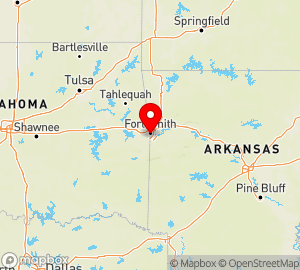Arkansas
Arkansas State Information

www.arkansas.gov
Area (sq mi):: 53178.62 (land 52068.17; water 1110.45) Population per square mile: 53.40
Population 2005: 2,779,154 State rank: 0 Population change: 2000-20005 4.00%; 1990-2000 13.70% Population 2000: 2,673,400 (White 78.60%; Black or African American 15.70%; Hispanic or Latino 3.20%; Asian 0.80%; Other 3.60%). Foreign born: 2.80%. Median age: 36.00
Income 2000: per capita $16,904; median household $32,182; Population below poverty level: 15.80% Personal per capita income (2000-2003): $21,925-$24,384
Unemployment (2004): 5.60% Unemployment change (from 2000): 0.70% Median travel time to work: 21.90 minutes Working outside county of residence: 23.40%
List of Arkansas counties:
Arkansas Parks
- US National Parks
- State Parks
- Parks and Conservation-Related Organizations - US
- National Wildlife Refuges
- National Trails
- National Scenic Byways
- National Forests
Arkansas
Twenty-fifth state; admitted on June 15, 1836 (seceded from the Union on May 6, 1861, and was readmitted in June 1868)
The state was named for Ohio Valley Indians’ name for the Quapaw Indians who lived in northern Arkansas.
State capital: Little Rock
Nickname: The Natural State
State motto: Regnat populus (Latin “The people rule”)
State beverage: Milk
State bird: Mockingbird (Mimus polyglottos)
State flower: Apple blossom (Malus sylvestris)
State folk dance: Square dance
State fruit and vegetable: South Arkansas vine-ripe pink tomato
State gem: Diamond
State insect: Honeybee (Apis mellifera)
State mammal: White-tail deer
State mineral: Quartz crystal
State musical instrument: Fiddle
State rock: Bauxite
State songs: “Arkansas,” “Arkansas (You Run Deep in Me),” “Oh Arkansas,” and “The Arkansas Traveler”
State tree: Pine (Pinus palustris)
More about state symbols at:
www.soskids.arkansas.gov/k-4-history-state-symbols.html
SOURCES:
AmerBkDays-2000, p. 448 AnnivHol-2000, p. 101
STATE OFFICES:
State web site: www.arkansas.gov
Office of the Governor State Capitol Bldg Little Rock, AR 72201 501-682-2345 fax: 501-682-1382 www.arkansas.gov/governor
Secretary of State State Capitol Bldg Rm 256 Little Rock, AR 72201 501-682-1010 fax: 501-682-3510 www.sosweb.state.ar.us
Arkansas State Library 1 Capitol Mall 5th Fl Little Rock, AR 72201 501-682-1527 fax: 501-682-1529 www.asl.lib.ar.us
Legal Holidays:
| Christmas Eve | Dec 24 |
| Martin Luther King Jr. Birthday and Robert E. Lee's Birthday | Jan 17, 2011; Jan 16, 2012; Jan 21, 2013; Jan 20, 2014; Jan 19, 2015; Jan 18, 2016; Jan 16, 2017; Jan 15, 2018; Jan 21, 2019; Jan 20, 2020; Jan 18, 2021; Jan 17, 2022; Jan 16, 2023 |
| Washington's Birthday and Daisy Gatson Bates Day | Feb 21, 2011; Feb 20, 2012; Feb 18, 2013; Feb 17, 2014; Feb 16, 2015; Feb 15, 2016; Feb 20, 2017; Feb 19, 2018; Feb 18, 2019; Feb 17, 2020; Feb 15, 2021; Feb 21, 2022; Feb 20, 2023 |
Arkansas
a state in the south of the USA. Area, 137,500 sq km. Population in 1967, 1,969,000; 43 percent urban (1960). Capital, Little Rock. In the east, Arkansas occupies the lowlands cut out by the Arkansas River on the right bank of the Mississippi; to the northwest are the Ouachita (about 863 m) and Boston (about 823 m) mountains. The climate is subtropical and humid (more than 1,000 mm of rain yearly). Yellow, red, and alluvial soils predominate. Subtropical forests (cypress, gum trees, and so on) grow in the valleys and floodlands; pine and oak, in elevated regions. The area of cultivated forests is 8.6 million hectares (ha). Arkansas has the South’s second largest reserves of hardwood. The value of agricultural commodity production and the relative net production of manufactured goods are approximately equal. Agriculture is highly developed. The main crops are cotton (area 286,000 ha, 118,000 tons in 1967, mainly in the Mississippi Valley), soybeans, and rice; Arkansas is fourth nationally in the production of cotton. Broilers (365 million in 1967) are the principal commodity in animal breeding.
Other industries are petroleum (slightly over 4 million tons in 1965), building materials, and bauxite (1,618,000 tons in 1965, more than nine-tenths of the US output). Among the manufacturing industries (129,000 employees) the food industry (packaging, preserving, and freezing chickens, fruits, berries, and so on), lumbering, and woodworking are most important. There are also radio and electronics and chemical industries (including production related to chemical warfare). There are aluminum factories in Jones Mill and Arkadelphia. Electric power plants provided 2.47 million kilowatts in 1966.
M. E. POLOVITSKAIA